Pay for the Cash, Get the $2 Billion Mine for Free
A classic deep-value asset-play case study.
This is the story of my first ever foray into mining stocks.
Before this point, I had been scared off. Almost everyone I spoke to told me that nothing good ever came from such stocks and I should do myself a favour and stay away.
The advice was always fearful but vague. Like when you mention doing a Ouija board to your dad.
Then, one day in January 2024, I found something irresistible.
It was a stock trading very close to its net-cash position, with a significant amount of other assets on the balance sheet and a very strong record of FCF earnings in recent years.
The business was called Base Resources (BSE) and it was an Australian based mining company.
They specialised in mineral sands, specifically, ilmenite, rutile and zircon.
These are used in a wide array of products and industries, from paint and ceramics to electronic components.
The mines were in Africa and it had a decent history of cash generation and profitability.
It had two mines that were particularly notable. The first one was in Kenya (Kwale Operation) and the second one was in Madagascar (Toliara Project).
The financial metrics (when I found it) were as follows:
NCAV Ratio: 3
TBV Ratio: 0.8
EV/FCF Ratio: 2.4
P/FCF Ratio: 3.6
5Y Shareholder Yield: 20%
These metrics were generated almost entirely by its Kenya operation because the other mine hadn’t started yet.
The government of Madagascar was wrangling over royalty terms which delayed production.
The problem with all of this was that the Kenyan mine was now exhausted and being wound down. The projected completion date for this was the end of 2024.
The market had started pricing this as an existential crisis.
You could purchase the entire company for less than the value of its tangible assets.
The market kind of had a point. No mines = no cash-flow.
Digging Deeper
This concerned me, so I started digging a bit more into the exact situation I’d be in if I bought the entire business as a private owner.
It turns out that a few weeks before I found it, the management team had upgraded their assessment of the Toliara project.
They estimated that the new mine had a net-present-value of $2 billion (with a B) USD.
So, if I did buy the entire company, I’d be paying for the cash and getting everything else, including this $2bn asset for free.
I could, theoretically, suck out the cash, cut all the costs and sell the assets. It was a risk-free bet.
My concern switched to excitement. Like when you find £20 in an old coat pocket.
The margin of safety seemed enormous and the main risk seemed to be the opportunity cost of holding the shares while management figured out how to proceed.
So, I bought at an average price of $0.16 per share. The stock then fell about 35% and stayed there for several weeks.
The Pay-out
In April 2024, I woke to an announcement that the management team had negotiated a sale of the business to a competitor.
The offer was $0.30 per share composed of $0.04 in cash and $0.26 in stock of the acquiring company.
The stock immediately jumped to $0.24 and later rallied to $0.29.
After researching the other stock I decided I didn’t much want to own those shares and took my position off at $0.24.
This gave me a profit of 40% in three months. I was perfectly happy with that.
Although, I did regret not putting more than 5% of my portfolio into the stock and also buying more when it dropped lower.
The Takeaway
This was a classic hidden asset play. The market focused on the vanishing cash flow and ignored the multi-billion-dollar mine.
And ironically, the “crisis” forced management to act, unlocking value much faster than anyone expected.
These kinds of setups exist right now.
You just have to know where to look.



